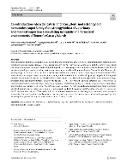Co-introduction into a delicate island ecosystem: metastrongyloid nematodes (superfamily Metastrongyloidea) of veterinary and medical importance circulating in aquatic and terrestrial environments of Tenerife (Canary Islands)

Author
Izquierdo-Rodriguez, Elena
Anettova, Lucia
Sipkova, Anna
Coufal, Radovan
Modry, David
Foronda, Pilar
Publication date
2024Published in
Parasitology ResearchVolume / Issue
123 (10)ISBN / ISSN
ISSN: 0932-0113ISBN / ISSN
eISSN: 1432-1955Metadata
Show full item recordCollections
This publication has a published version with DOI 10.1007/s00436-024-08364-1
Abstract
Metastrongyloid nematodes typically reside as adults in the cardiopulmonary systems of their mammalian definitive hosts, potentially causing severe diseases. Of particular concern are Angiostrongylus cantonensis and A. costaricensis, which can cause eosinophilic meningitis and abdominal angiostrongyliasis, respectively, in their accidental human hosts. Several metastrongyloid species of medical and veterinary importance have been documented in the Canary Islands. However, the gastropod species acting as intermediate hosts for some of these nematodes in the archipelago remained unknown. This study aimed to investigate the occurrence of metastrongyloid nematodes in terrestrial and aquatic gastropods, including both endemic and non-native species, on Tenerife. Foot samples from terrestrial and aquatic gastropods were analyzed using a multiplex PCR targeting the Internal Transcribed Spacer 1 (ITS1), allowing the specific detection of A. cantonensis, A. vasorum, Aelurostrongylus abstrusus, Crenosoma striatum, Troglostrongylus brevior, and Crenosoma vulpis. Five metastrongyloid species, namely C. striatum, A. cantonensis, Ae. abstrusus, A. vasorum, and an unidentified metastrongyloid, were identified within both non-native and endemic terrestrial gastropods. In the aquatic snail Physella acuta, only A. cantonensis and C. striatum were detected. This study confirms the introduction of various metastrongyloids associated with non-native mammalian fauna and provides new data on the occurrence of these nematodes in non-native and endemic gastropod species, including their presence in aquatic environments on the Canary Islands.
Keywords
Angiostrongylus cantonensis, Angiostrongylus vasorum, Aelurostrongylus abstrusus, Crenosoma striatum, Metastrongyloids, Canary Islands,
Permanent link
https://hdl.handle.net/20.500.14178/2711License
Full text of this result is licensed under: Creative Commons Uveďte původ 4.0 International







